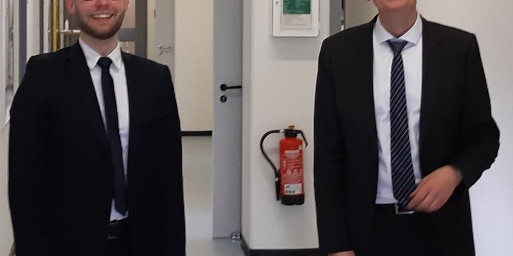Aktuelles vom Arbeitsgebiet Bordsysteme
Erfolgreicher Abschluss des Promotionsverfahrens von Andreas Bendicks

Andreas Bendicks hat am 30.06.2020 die Prüfung zu seiner Doktorarbeit mit dem Titel "Active Cancellation of Electromagnetic Emissions of Power Electronic Systems by Injecting Synthesized and Synchronized Signals" erfolgreich bestanden.
Andreas Bendicks hat sich im Rahmen seiner Doktorarbeit am Arbeitsgebiet Bordsysteme mit der aktiven Unterdrückung der elektromagnetischen Störungen von leistungselektronischen Systemen beschäftigt. Im Gegensatz zu bisherigen Ansätzen werden in seiner Arbeit künstlich erzeugte (synthetisierte) Gegenstörsignale mithilfe eines digitalen Signalverarbeitungssystems erzeugt, um eine destruktive Interferenz mit den Störungen zu erzielen. Die Doktorarbeit wird in Kürze online bei der Hochschulbibliothek verfügbar sein.
Zusammenfassung der Arbeit:
In this thesis, a new method is developed for the active cancellation of predictable EMI by injecting synthesized and synchronized signals. At first, a generic description is derived for the active cancellation of conducted EMI of arbitrary single- and multi-port electronic systems. From the mathematical description, important requirements for the overall system and the cancellation signals are found.
Analog active EMI filters as an established method for active EMI cancellation are discussed. These use analog circuitry to generate the cancellation signals from a measured quantity by a feedback or feedforward approach. It is shown that the performance of these structures is systematically limited by the amplifiers' gain-bandwidth products (that can also be interpreted as time constants) and the finite propagation speed of electrical signals.
Digital active EMI filters use digital signal processing hardware instead of analog amplifiers in the feedback or feedforward structures. By doing so, restricting gain-bandwidth products are avoided. However, the signal processing causes significant delay times that limit the performance of these systems.
Active cancellation methods and systems in the fields of power quality and acoustics are reviewed for their applicability to active EMI cancellation. The most promising approaches are applicable to periodic disturbances. These synthesize artificial cancellation signals and inject them in synchronicity with the disturbances. For quasi-periodic EMI, these systems can use the knowledge of the past for the future. Therefore, time constants and delay times can be compensated by shaping the cancellation signal and injecting it earlier than the EMI occurs. By doing so, the signal generation is no limiting factor for the achievable EMI reduction anymore. The remaining limitations are the capabilities of the digital hardware.
These methods are further abstracted to a new active cancellation technique that uses synthesized and synchronized cancellation signals. This method requires the EMI to be predictable so that the cancellation signals can be synthesized and injected at the right time. The predictability is given for quasi-periodic signals (since the past signals allow for an extrapolation into the future), but may also be given for non-periodic signals if there is sufficient knowledge on the upcoming events. Various possibilities for implementation are discussed.
The method is realized by an FPGA system with an ADC and a DAC, or a laboratory setup consisting of arbitrary waveform generators, an oscilloscope and a PC. The FPGA system is investigated and applied to one port of a DC-to-DC converter and a PFC. The laboratory setup is first applied to one and afterward to multiple ports of a DC-to-DC converter. After a system identification, the components are purposefully designed to fulfill specific EMI requirements. Measurement results demonstrate the high potential of the method with promising EMI reductions of up to 64 dB for 1 MHz and up to 47 dB for frequencies of up to 30 MHz.

